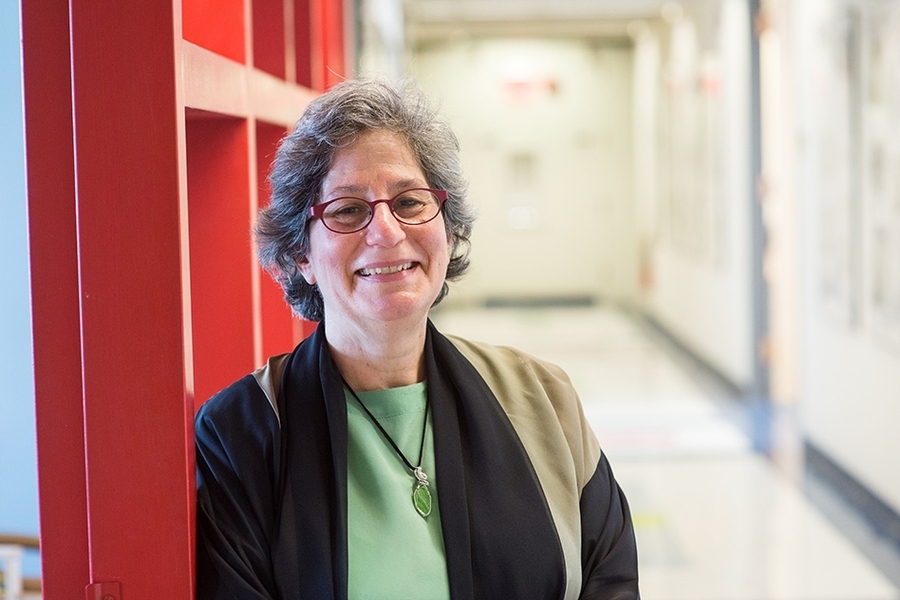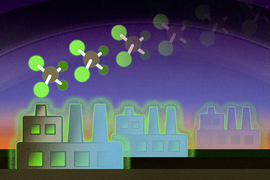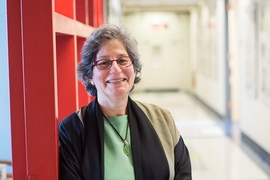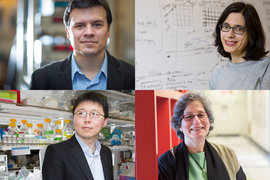Susan Solomon, an atmospheric chemist whose work explaining the Antarctic ozone hole informed international policy, has received the 2020-2021 James R. Killian, Jr. Faculty Achievement Award. The highest such honor at the Institute, the award was established in 1971 to honor Killian, who served as MIT’s 10th president from 1948 to 1959, and chair of the MIT Corporation from 1959 to 1971.
As this year’s recipient, Solomon on April 14 delivered a one-hour lecture in which she touched on her path to MIT, her time in Antarctica, her work on ozone depletion, and her insights on the state of climate policy.
Solomon is the Lee and Geraldine Martin Professor of Environmental Studies in the Department of Earth, Atmospheric, and Planetary Sciences. She arrived at MIT in 2012, following 30 years at the National Oceanic and Atmospheric Administration. Though both an Antarctic glacier and a snow saddle bear her name, at the lecture, Solomon described the Killian award as “the most wonderful honor that anyone could get.”
Solomon “is the embodiment of MIT’s motto ‘mens et manus’ or ‘mind and hand,’ and of our mission to generate, disseminate, and preserve knowledge, and to work with others to bring this knowledge to bear on the world’s great challenges,” said Rick Danheiser, the Arthur C. Cope Professor of Chemistry and current chair of the faculty, who introduced Solomon.
Solomon had an affinity for science and the beauty of the natural world long before she was exploring the Antarctic alongside penguins. Growing up, Solomon would travel every year with her family from their home in Chicago to Indiana Dunes National Park. Around age 10, she was inspired by the wonderful adventures of French explorer and scientist Jacques Cousteau on TV. Solomon decided to pursue a career in science, and soon discovered an interest in chemistry.
“At some point, I found out that there was really such a thing as chemistry in a planet’s atmosphere — not in a test tube,” she said. “And I was absolutely fascinated by that.”
In 1974, scientists at the University of California at Irvine identified that chlorofluorocarbons (CFCs) — compounds which were becoming increasingly popular for use in canned hairsprays, deodorants, and cleaning supplies, as well as refrigeration and cooling systems — had devastating effects on Earth’s ozone. Even worse, once the compounds were released, they couldn’t be destroyed. Rather, they were destined to remain in the atmosphere for 40 to 150 years.
Ozone is a gas made of three oxygen atoms, and much of it can be found in the stratosphere. The stratosphere is the second layer of Earth’s atmosphere, located between 9 and 50 miles above the Earth. CFCs were depleting the layer of ozone located there, which helps to filter out ultraviolet radiation that can be toxic to living beings. Without ozone, life wouldn’t exist on Earth. And with reduced levels of ozone, there could be increases in skin cancer and cataracts.
In 1985, scientists discovered a large, shocking “hole” in the Antarctic ozone layer.
“I was very, very fortunate to be working with Rolando Garcia at [National Center for Atmospheric Research] at the time that the ozone hole was discovered,” Solomon said. “We began to think about what might be causing it, and what we came up with, basically, was this chemical process which turned out to be the right answer.”
Between 1985 and 1987, scientists from around the world independently studied ozone levels to verify the scope of the problem. In 1986, Solomon first set foot in Antarctica as part of the National Ozone Expedition.
What followed these scientific investigations was a triumph of international climate policy: the Montreal Protocol, a 1987 document signed by all members of the United Nations. The document was designed to limit CFC emissions and to restore the ozone layer. “It's the only treaty that has that level of participation,” Solomon said.
Solomon said that swift action on the issue came down to the three "p's": The ozone issue was personal, perceptible, and practical. Risks posed by CFCs were personal because they could spike cancer and cataract risk; perceptible because many nations were monitoring ozone levels and noticed the change; and practical because replacements were discovered.
“I think when we think about almost any environmental problem, we can apply that rubric, and it will help us to understand what's going on,” Solomon said, identifying smog and lead as examples. She is currently working on a book about the three p's.
Solomon went on to receive the United States National Medal of Science in 1999, the nation’s highest scientific honor. In 2007, she and her colleagues on the Intergovernmental Panel on Climate Change shared the Nobel Peace Prize with former Vice President Al Gore. This January, she was awarded the National Academy of Sciences Award for Chemistry in service to society.
AT MIT, Solomon is not only faculty in two departments, but also the founding director of the Environmental Solutions Initiative, an Institute-wide coalition of experts working to address the serious challenges posed by climate change.
“It’s amazing at MIT how everyone you meet is very, very good at what they do,” Solomon said. “It’s an astonishing place. I want to thank the EAPS and chemistry faculties for making me feel so welcome. I can’t imagine a better place to live, do research, and teach.”











